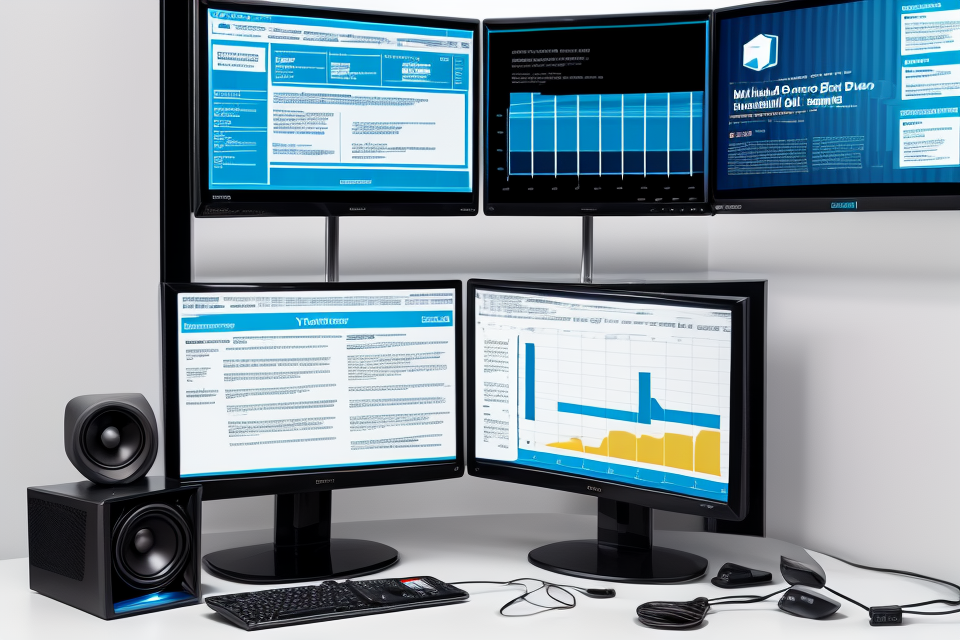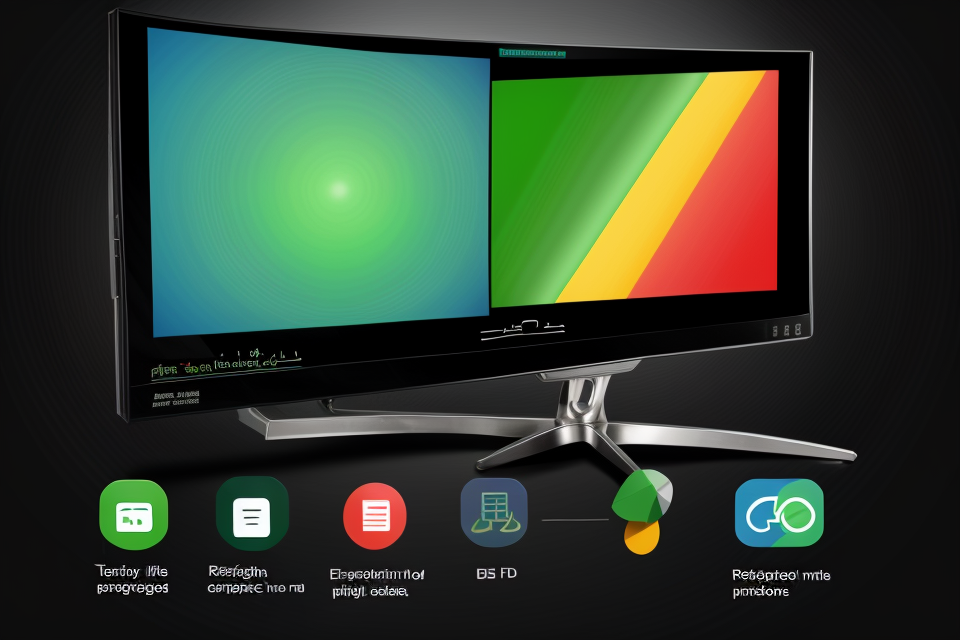
Variable refresh rate monitors have revolutionized the world of gaming by offering smooth and seamless gameplay. However, despite their numerous benefits, these monitors also have some drawbacks that need to be considered before making a purchase. In this article, we will explore the cons of variable refresh rate monitors and provide you with a comprehensive understanding of their limitations. Whether you’re a hardcore gamer or a casual player, this article will help you make an informed decision about whether a variable refresh rate monitor is right for you. So, let’s dive in and explore the potential drawbacks of these innovative monitors.
Variable refresh rate monitors offer several benefits, such as improved visual quality and reduced input lag. However, there are also some drawbacks to consider. One major drawback is the potential for screen tearing, which can occur when the monitor’s refresh rate is not synchronized with the frame rate of the content being displayed. This can result in a distracting and potentially damaging effect on the screen. Additionally, variable refresh rate monitors may also have a higher cost compared to traditional monitors, and may require a more powerful graphics card to operate. Furthermore, some games or applications may not be optimized for variable refresh rate monitors, which can result in a reduced performance.
Understanding variable refresh rate monitors
How variable refresh rate monitors work
Variable refresh rate monitors are designed to adjust their refresh rate based on the content being displayed on the screen. This feature is intended to save power by reducing the refresh rate when the content is static and increasing it when the content is dynamic. While this feature can be beneficial in some cases, it can also have some drawbacks.
One of the main drawbacks of variable refresh rate monitors is that they can cause visual artifacts. These artifacts can include ghosting, where trailing images appear behind moving objects, and tearing, where the image appears to be split into two parts. These artifacts can be particularly noticeable in fast-paced games or movies, where the content is constantly changing.
Another drawback of variable refresh rate monitors is that they can cause inconsistent performance. Because the refresh rate is adjusted based on the content being displayed, the monitor may not always be able to keep up with the most demanding content. This can result in dropped frames or other performance issues, which can be frustrating for users.
Finally, variable refresh rate monitors can be more difficult to set up and configure than traditional monitors. Because the refresh rate is adjusted based on the content being displayed, the monitor may require additional settings or software to ensure that it is operating at the optimal refresh rate for the content being displayed. This can be confusing for some users, and may require additional technical expertise to get everything working properly.
The benefits of variable refresh rate monitors
Variable refresh rate monitors offer several benefits that make them an attractive option for gamers and other users who require smooth and seamless visuals. These benefits include:
- Improved gaming performance: With a variable refresh rate monitor, the refresh rate can be dynamically adjusted based on the content being displayed. This means that the monitor can refresh at a higher rate when displaying fast-moving content, such as in video games, which can lead to smoother and more responsive gameplay.
- Reduced screen tearing and stuttering: Traditional monitors have a fixed refresh rate, which can cause screen tearing and stuttering in certain situations. With a variable refresh rate monitor, these issues can be minimized or eliminated altogether, leading to a more immersive and seamless visual experience.
- Energy efficiency: Since the refresh rate of a variable refresh rate monitor can be adjusted based on the content being displayed, it can be more energy efficient than traditional monitors. This is because it only refreshes at the highest possible rate when necessary, rather than continuously at a fixed rate.
- Reduced strain on the eyes: Because the refresh rate of a variable refresh rate monitor can be adjusted to match the content being displayed, it can also reduce strain on the eyes. This is because the monitor is not constantly refreshing at a high rate, which can cause visual fatigue over time.
Overall, the benefits of variable refresh rate monitors make them a compelling option for anyone who values smooth and seamless visuals, whether for gaming, work, or other applications.
The cons of variable refresh rate monitors
Image retention and burn-in
One of the primary concerns associated with variable refresh rate monitors is the potential for image retention and burn-in.
Image retention
Image retention refers to the temporary or permanent display of an image on the screen even after the source image has been removed. This can be a result of the display’s inability to fully refresh the image in a timely manner, leading to a residual image being displayed for a period of time after the original image has been replaced.
While this issue is generally temporary and will disappear on its own after a short period of time, it can be distracting and annoying for users who experience it. Additionally, some users may be more susceptible to image retention than others, which can make it a more significant issue for certain individuals.
Burn-in
Burn-in, on the other hand, refers to the permanent display of an image on the screen due to the display’s inability to fully refresh the image in a specific area. This can occur when a static image is displayed for an extended period of time, leading to a “ghost” image being displayed even after the original image has been removed.
Burn-in can be a significant issue for users who regularly use their displays for extended periods of time with static images, such as in gaming or other graphically intensive applications. If left untreated, burn-in can become permanent and can lead to a degradation in the overall quality of the display.
In order to mitigate the risk of image retention and burn-in, it is important to ensure that the display is properly calibrated and that the image being displayed is not static for extended periods of time. Additionally, it may be helpful to periodically refresh the display by moving the cursor or displaying a moving image to help prevent the accumulation of static images in specific areas of the screen.
Compatibility issues with certain games and applications
One of the major drawbacks of variable refresh rate monitors is that they may not be compatible with certain games and applications. This is because some games and applications are not designed to work with VRR technology, and as a result, they may not perform optimally or may not work at all.
Additionally, some games and applications may have a fixed frame rate that is not compatible with the variable refresh rate of the monitor. This can result in a lag or stutter in the gameplay, which can be frustrating for gamers.
Another issue with compatibility is that some games and applications may not support the same refresh rate range as the monitor. For example, if a monitor supports a refresh rate range of 40-144Hz, some games may only support a range of 60-120Hz. This can result in the game running at a lower frame rate than the monitor’s maximum refresh rate, which can lead to a less than optimal gaming experience.
Overall, compatibility issues with certain games and applications can be a significant drawback of variable refresh rate monitors, particularly for gamers who rely on specific titles to run smoothly.
Limited to certain refresh rate ranges
While variable refresh rate monitors offer several advantages, there are some drawbacks to consider as well. One of the primary limitations of these monitors is that they are only capable of displaying refresh rates within a specific range. This means that if the content being displayed requires a refresh rate outside of the monitor’s capabilities, it may not be displayed correctly.
For example, if a monitor is capable of displaying refresh rates between 60Hz and 144Hz, it will not be able to display content that requires a refresh rate of 240Hz or higher. This can be a significant limitation for certain types of content, such as fast-paced video games or high-speed sports, where smooth and seamless motion is critical.
Furthermore, this limitation can also affect the overall user experience, as users may find that certain content appears choppy or incomplete due to the monitor’s inability to display the required refresh rate. As a result, it is important to carefully consider the refresh rate capabilities of a variable refresh rate monitor before making a purchase, particularly if you plan to use it for content that requires high refresh rates.
Price
Variable refresh rate monitors are a relatively new technology, and as such, they tend to be more expensive than traditional monitors. This higher cost is due to several factors, including the added complexity of the display panel and the additional hardware required to support the variable refresh rate feature.
One of the main reasons for the higher cost is the inclusion of an additional hardware chip called a DisplayPort (DP) 1.4 hub. This chip is required to enable the variable refresh rate feature, and it adds to the overall cost of the monitor. Additionally, some variable refresh rate monitors may require a graphics card that supports the DisplayPort 1.4 standard, which can further increase the cost of the overall system.
Another factor contributing to the higher cost of variable refresh rate monitors is the use of more advanced display panels. These panels typically have a higher refresh rate and support for a wider range of colors, which can result in better image quality. However, these advanced panels are also more expensive to produce, which can contribute to the higher cost of the monitor.
It’s worth noting that while the higher cost of variable refresh rate monitors may be a significant drawback for some consumers, the improved image quality and reduced input lag can make them a worthwhile investment for gamers and other users who value smooth and responsive visuals.
Limited warranty coverage
While variable refresh rate monitors offer a range of benefits, there are some drawbacks to consider as well. One of the key disadvantages of these monitors is the limited warranty coverage that they typically come with. Unlike traditional monitors, which often come with a standard warranty of 1-3 years, variable refresh rate monitors may only be covered for a shorter period of time. This can leave users vulnerable to costly repairs or replacements if something goes wrong with their monitor outside of the warranty period.
In addition, some manufacturers may not provide the same level of support or repair services for variable refresh rate monitors as they do for other types of monitors. This means that users may need to seek out third-party repair services or purchase extended warranties to ensure that their monitor is covered in the event of a problem. Overall, the limited warranty coverage on variable refresh rate monitors can be a significant drawback for users who value the peace of mind that comes with a comprehensive warranty.
Is a variable refresh rate monitor right for you?
Factors to consider before purchasing a variable refresh rate monitor
Before making the decision to purchase a variable refresh rate monitor, it is important to consider several factors to determine if it is the right choice for your needs. Here are some factors to consider:
1. Gaming preferences
The primary benefit of a variable refresh rate monitor is its ability to reduce motion blur and provide a smoother gaming experience. Therefore, if you are a avid gamer and value a seamless and fluid gaming experience, a variable refresh rate monitor may be the right choice for you.
2. Budget
Variable refresh rate monitors tend to be more expensive than traditional monitors, and the cost can vary depending on the refresh rate range and the monitor’s size. It is important to consider your budget and determine if the additional cost is justified for the benefits it provides.
3. Compatibility with other devices
It is important to consider the compatibility of a variable refresh rate monitor with other devices such as laptops, gaming consoles, and graphics cards. Some monitors may require specific graphics cards or software to function properly, so it is important to ensure that your devices are compatible before making a purchase.
4. Usage patterns
Consider your usage patterns and determine if a variable refresh rate monitor will provide a noticeable improvement in your experience. For example, if you primarily use your monitor for work or productivity tasks, the benefits of a variable refresh rate monitor may be less significant compared to a gamer who experiences motion blur frequently.
In conclusion, there are several factors to consider before purchasing a variable refresh rate monitor. By evaluating your gaming preferences, budget, compatibility with other devices, and usage patterns, you can determine if a variable refresh rate monitor is the right choice for you.
Alternatives to variable refresh rate monitors
When considering whether a variable refresh rate monitor is the right choice for you, it’s important to explore alternative options. Some potential alternatives include:
- Static refresh rate monitors: These monitors have a fixed refresh rate that remains constant regardless of the content being displayed. While this may not provide the same level of smoothness as a variable refresh rate monitor, it can still deliver a high-quality viewing experience for most users.
- Gaming monitors with a high fixed refresh rate: These monitors have a fixed refresh rate that is higher than the standard 60Hz. This can provide a smoother gaming experience, particularly for fast-paced games. However, they may not be as adaptable to different types of content as a variable refresh rate monitor.
- Televisions with a high frame rate: If you’re looking for a larger screen and don’t require the same level of responsiveness as a gaming monitor, a television with a high frame rate may be a good alternative. Some televisions now offer frame rates of up to 120Hz, which can provide a more fluid viewing experience.
- Professional-grade monitors: For users who require the highest level of performance and precision, such as video editors or graphic designers, a professional-grade monitor may be a better option. These monitors typically have a higher resolution, wider color gamut, and more advanced features than consumer-grade monitors.
It’s important to consider your specific needs and requirements when choosing a monitor, and to weigh the pros and cons of each option. While a variable refresh rate monitor may offer some advantages, it may not be the best choice for everyone.
Recap of the pros and cons of variable refresh rate monitors
When considering the pros and cons of variable refresh rate monitors, it is important to evaluate the specific use case and personal preferences of the user. While these monitors offer numerous benefits, such as improved visual quality and reduced strain on the eyes, they also come with some potential drawbacks.
One potential drawback of variable refresh rate monitors is the increased cost compared to traditional monitors. The technology required to enable a variable refresh rate is still relatively new, and as a result, the monitors themselves tend to be more expensive. This may make them less accessible to budget-conscious consumers.
Another potential drawback is the potential for compatibility issues with certain games or applications. While many modern games and applications are designed to work seamlessly with variable refresh rate monitors, older or less popular titles may not be compatible. This can result in visual artifacts or other issues that can detract from the overall experience.
Additionally, some users may find that the variable refresh rate feature is not as useful as they had anticipated. While it can be incredibly helpful for certain tasks, such as gaming or video editing, it may not offer as much benefit for more casual users who simply need a reliable monitor for everyday tasks.
Finally, it is worth noting that variable refresh rate monitors may require more maintenance and upkeep than traditional monitors. The technology used to enable the variable refresh rate feature can be more sensitive to certain environmental factors, such as temperature and humidity, which may require more careful monitoring and maintenance to ensure optimal performance.
Overall, while variable refresh rate monitors offer numerous benefits, it is important to carefully consider the potential drawbacks and determine whether the technology is the right choice for your specific needs and preferences.
Final thoughts on whether a variable refresh rate monitor is worth the investment
In conclusion, a variable refresh rate monitor can be a great investment for gamers who want a competitive edge and a seamless gaming experience. However, it’s important to consider the potential drawbacks and determine if the benefits outweigh the costs.
One potential drawback is the increased cost of purchasing a monitor with a variable refresh rate. These monitors tend to be more expensive than traditional monitors, which may not be within the budget for all gamers. Additionally, the need for a powerful graphics card to take full advantage of the variable refresh rate can add to the overall cost of the setup.
Another consideration is the potential for visual artifacts or inconsistencies in the image quality when using a variable refresh rate monitor. While these issues are relatively rare, they can occur in certain situations, such as when using a lower-end graphics card or when running certain games or applications.
Overall, a variable refresh rate monitor can be a great investment for serious gamers who are looking to enhance their gaming experience. However, it’s important to weigh the potential drawbacks against the benefits and determine if the investment is worth it for your specific needs and budget.
FAQs
1. What is a variable refresh rate monitor?
A variable refresh rate monitor is a type of display technology that allows the refresh rate to vary dynamically based on the content being displayed. This means that the monitor can adjust its refresh rate to match the frame rate of the content, resulting in smoother and more fluid motion.
2. What are the benefits of a variable refresh rate monitor?
The main benefit of a variable refresh rate monitor is that it can improve the overall gaming experience by reducing motion blur and providing smoother, more fluid motion. This can enhance the realism and immersion of games, and make them more enjoyable to play.
3. What are the drawbacks of a variable refresh rate monitor?
One potential drawback of a variable refresh rate monitor is that it can cause some compatibility issues with certain games or applications. This is because some games or applications may not be designed to work with a variable refresh rate monitor, and may not be able to take advantage of its features. Additionally, a variable refresh rate monitor may not be compatible with certain types of input devices, such as older gaming controllers, which may not be able to handle the higher refresh rates.
4. Can a variable refresh rate monitor cause any health issues?
There is no evidence to suggest that a variable refresh rate monitor can cause any health issues. However, as with any display technology, it is important to take regular breaks to avoid eye strain and other symptoms of visual fatigue. It is also important to maintain good posture and ergonomic practices while using a monitor, as this can help reduce the risk of developing discomfort or injury.
5. How do I adjust the refresh rate on a variable refresh rate monitor?
The process for adjusting the refresh rate on a variable refresh rate monitor will vary depending on the specific monitor and the operating system being used. In general, however, it should be possible to adjust the refresh rate through the monitor’s on-screen display (OSD) settings or through the display settings in the operating system. The specific steps for adjusting the refresh rate will depend on the monitor and the operating system being used, so it may be necessary to consult the monitor’s manual or online documentation for more information.


